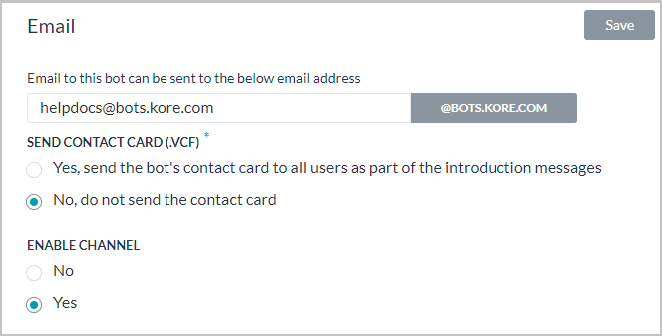When you add the email channel to your bot, Kore.ai automatically generates the email address that the end-users can send an email for communications with your bot. By default, the email address syntax is < bot name >.kore@m.< kore host >. For example, assembla.kore@m.app-bots.kore.com. Optionally, you can click Change to add a custom name, such as MyBot.kore@m.app-bots.kore.com
On adding the email channel to your bot, end-users for your bot can interact with your bot using any standard email client, such as Microsoft Outlook or Yahoo.
Add Email Channel
To add the email channel, follow the below steps:
- In the Bots section of the Bot Builder, click the bot that you want to add the email channel to.
- On the Channels tab, click the Email icon. The Email Channel page is displayed.
- Optionally, in the Email field, you can change the first portion of the address set to the bot name by default.
- Under the Enable Channel section, select Yes to enable the channel.
- Click Save.

The Channel added successfully message is displayed.
Edit Email Channel
To edit the email channel, follow the below steps:
- Hover over the channel and click to modify.
- You can make necessary updates to your channel configurations and save them.
- You can also disable or delete the channel information by clicking the Settings icon.

Select one of the following commands to modify the channel:
- Disable/Enable
- Click Disable to temporarily disable the use of the email channel for your bot. To enable the use of the email channel, Click Enable.
- Delete
- Click Delete.
- On the Delete Confirmation dialog box, click OK to permanently delete the Bot channel configuration.
